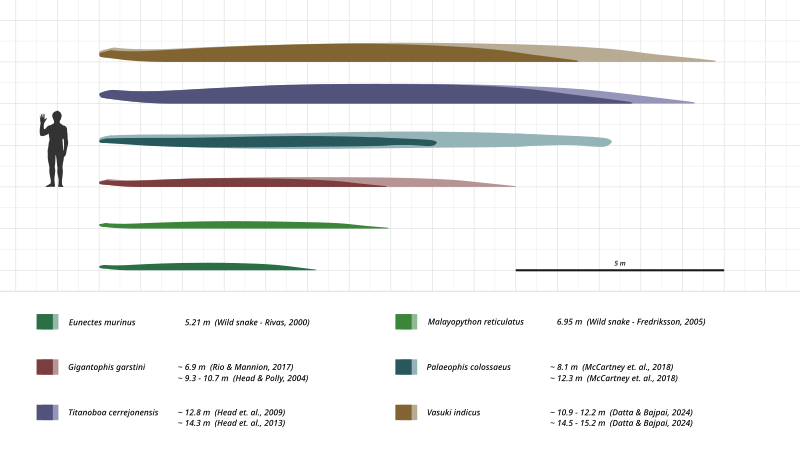Datei:Eunectes-murinus -Broghammerus-reticulatus- -Titanoboa-2.svg
Aus besserwiki.de

Größe der PNG-Vorschau dieser SVG-Datei: 800 × 267 Pixel. Weitere Auflösungen: 320 × 107 Pixel | 640 × 213 Pixel | 1.024 × 341 Pixel | 1.280 × 427 Pixel | 2.560 × 853 Pixel | 1.440 × 480 Pixel.
Originaldatei (SVG-Datei, Basisgröße: 1.440 × 480 Pixel, Dateigröße: 182 KB)
Diese Datei stammt aus Wikimedia Commons und kann von anderen Projekten verwendet werden. Die Beschreibung von deren Dateibeschreibungsseite wird unten angezeigt.
Beschreibung
| BeschreibungEunectes-murinus -Broghammerus-reticulatus- -Titanoboa-2.svg |
English: A size comparison of four different snakes; comparing large individuals of the extant green anaconda (Eunectes murinus) and reticulated python (Malayopython reticulatus) to total length estimates of the extinct Gigantophis and Titanoboa.
References
|
| Datum | |
| Quelle | Eigenes Werk |
| Urheber | Gamma 124 |
Lizenz
Ich, der Urheber dieses Werkes, veröffentliche es unter der folgenden Lizenz:
Diese Datei ist lizenziert unter der Creative-Commons-Lizenz „Namensnennung – Weitergabe unter gleichen Bedingungen 4.0 international“.
- Dieses Werk darf von dir
- verbreitet werden – vervielfältigt, verbreitet und öffentlich zugänglich gemacht werden
- neu zusammengestellt werden – abgewandelt und bearbeitet werden
- Zu den folgenden Bedingungen:
- Namensnennung – Du musst angemessene Urheber- und Rechteangaben machen, einen Link zur Lizenz beifügen und angeben, ob Änderungen vorgenommen wurden. Diese Angaben dürfen in jeder angemessenen Art und Weise gemacht werden, allerdings nicht so, dass der Eindruck entsteht, der Lizenzgeber unterstütze gerade dich oder deine Nutzung besonders.
- Weitergabe unter gleichen Bedingungen – Wenn du das Material wiedermischst, transformierst oder darauf aufbaust, musst du deine Beiträge unter der gleichen oder einer kompatiblen Lizenz wie das Original verbreiten.
Kurzbeschreibungen
Ergänze eine einzeilige Erklärung, was diese Datei darstellt.
Big snake
In dieser Datei abgebildete Objekte
Motiv
Einige Werte ohne einen Wikidata-Eintrag
29. April 2018
image/svg+xml
Dateiversionen
Klicke auf einen Zeitpunkt, um diese Version zu laden.
| Version vom | Vorschaubild | Maße | Benutzer | Kommentar | |
|---|---|---|---|---|---|
| aktuell | 12:55, 24. Apr. 2019 | 1.440 × 480 (182 KB) | wikimediacommons>Steveoc 86 | Typo - 14.9 to 14.3 |
Dateiverwendung
Die folgende Seite verwendet diese Datei:
Metadaten
Diese Datei enthält weitere Informationen, die in der Regel von der Digitalkamera oder dem verwendeten Scanner stammen. Durch nachträgliche Bearbeitung der Originaldatei können einige Details verändert worden sein.
| Breite | 1440 |
|---|---|
| Höhe | 480 |